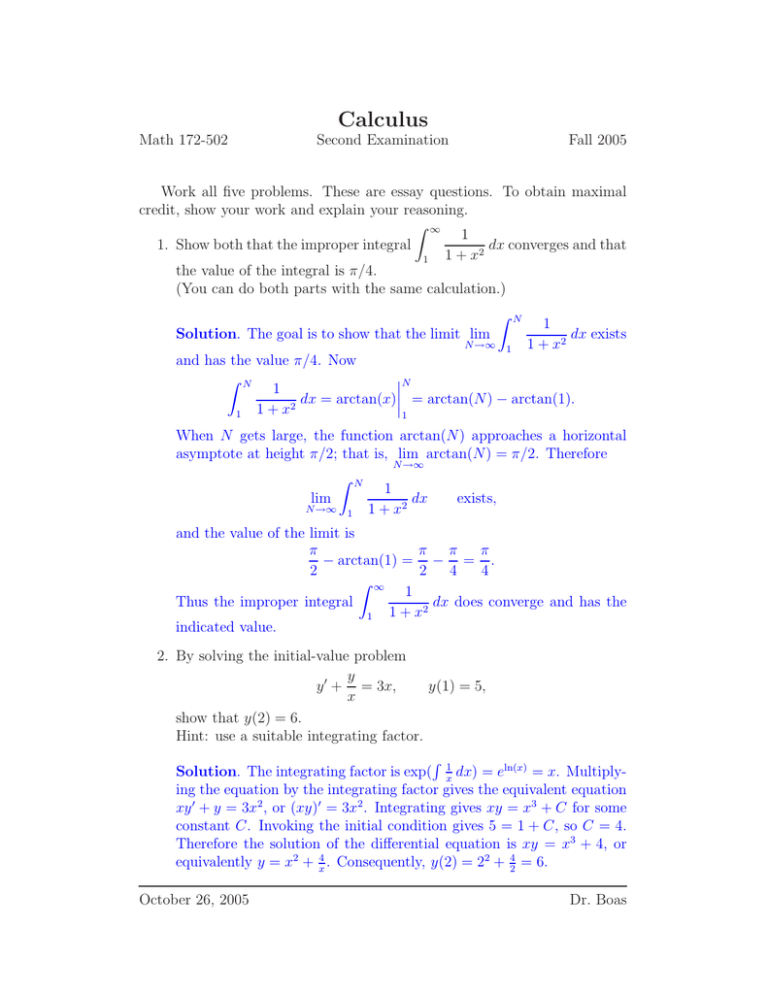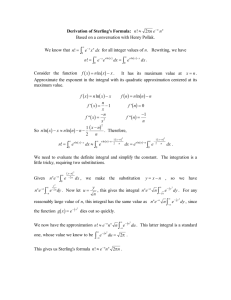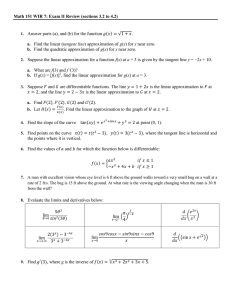Calculus
advertisement

Calculus Math 172-502 Second Examination Fall 2005 Work all five problems. These are essay questions. To obtain maximal credit, show your work and explain your reasoning. Z ∞ 1 1. Show both that the improper integral dx converges and that 1 + x2 1 the value of the integral is π/4. (You can do both parts with the same calculation.) Solution. The goal is to show that the limit lim N →∞ Z 1 N 1 dx exists 1 + x2 and has the value π/4. Now N Z N 1 = arctan(N) − arctan(1). dx = arctan(x) 2 1 + x 1 1 When N gets large, the function arctan(N) approaches a horizontal asymptote at height π/2; that is, lim arctan(N) = π/2. Therefore N →∞ lim N →∞ Z 1 N 1 dx 1 + x2 exists, and the value of the limit is π π π π − arctan(1) = − = . 2 2 4 4 Z ∞ 1 Thus the improper integral dx does converge and has the 1 + x2 1 indicated value. 2. By solving the initial-value problem y y ′ + = 3x, y(1) = 5, x show that y(2) = 6. Hint: use a suitable integrating factor. R Solution. The integrating factor is exp( x1 dx) = eln(x) = x. Multiplying the equation by the integrating factor gives the equivalent equation xy ′ + y = 3x2 , or (xy)′ = 3x2 . Integrating gives xy = x3 + C for some constant C. Invoking the initial condition gives 5 = 1 + C, so C = 4. Therefore the solution of the differential equation is xy = x3 + 4, or equivalently y = x2 + x4 . Consequently, y(2) = 22 + 24 = 6. October 26, 2005 Dr. Boas Calculus Math 172-502 Second Examination Fall 2005 3. The surface area of a hemisphere of radius 1 is equal to 2π. Verify this fact by computing the area of the surface obtained by revolving the curve x = cos(t), y = sin(t), 0 ≤ t ≤ π/2 about the y-axis. (The curve is one quarter of a circle.) Solution. The arc length element in this problem is s 2 2 p dy dx ds = + dt = sin2 t + cos2 t dt = dt. dt dt The surface area is therefore π/2 Z ∗∗ Z π/2 2πx ds = 2π cos(t) dt = 2π sin(t) = 2π(1 − 0) = 2π. 0 ∗ 0 4. Suppose f is an increasing function whose graph is concave down. If f (2) = 1.1, f (3) = 1.25, and f (4) = 1.33, find an approximate value Z 4 for the integral f (x) dx with error less than 4%. Explain how you 2 know that the error is less than 4%. Hint: for a curve of the indicated type, the trapezoidal approximation is an under-estimate of the area, and the midpoint approximation is an over-estimate of the area. Solution. The question can be answered by using the simplest possible trapezoidal and midpoint approximations, without even subdividing the interval [2, 4]. The area of a trapezoid whose base is the interval [2, 4] and whose upper side joins the endpoints of the curve is (base) × (average altitude) = 2 × 21 (1.1 + 1.33) = 2.43. This value is a lower estimate for the area under the curve (because the function is concave down). The area of a rectangle whose base is the interval [2, 4] and whose height is the value of the function at the midpoint is 2 × 1.25 = 2.50. This value is an upper estimate for the area under the curve (because the function is concave down). Thus Z 4 2.43 ≤ f (x) dx ≤ 2.50. 2 October 26, 2005 Dr. Boas Calculus Math 172-502 Second Examination Fall 2005 Therefore both the trapezoidal approximation and the midpoint approximation differ from the true value of the integral by no more than 2.50 − 2.43 = 0.07. Since 0.07/2.43 ≈ 0.0288, both the trapezoidal approximation and the midpoint approximation are accurate not only within 4% but even within 3%. The preceding discussion suffices to answer the question, but one can do better by using the trapezoidal approximation with two subintervals [2, 3] and [3, 4], each of width 1. That improved approximation equals 1 (1.1 + 1.25) + 12 (1.25 + 1.33) = 2.465. The midpoint approximation 2 with two subintervals would require the values f (2.5) and f (3.5), which are not given. Using the midpoint approximation previously computed and the second trapezoidal approximation shows that Z 4 2.465 ≤ f (x) dx ≤ 2.50. 2 Therefore both this second trapezoidal approximation and the midpoint approximation differ from the true value of the integral by no more than 2.50 − 2.465 = 0.035. Since 0.035/2.465 ≈ 0.014, both the second trapezoidal approximation and the midpoint approximation have an error less than 2%. A further improvement is to average the second trapezoidal approximation and the midpoint approximation to get 12 (2.465 + 2.50) = 2.4825. This value differs from the true value of the integral by at most 12 (2.50 − 2.465) = 0.0175. Hence the relative error is at most 0.0175/2.465 ≈ 0.007, or less than 1%. 5. Do either part (a) or part (b), whichever you prefer. (a) Show that lim (−1)n sin(1/n) = 0. n→∞ Solution. A popular inadequate answer is: “Since limn→∞ sin(1/n) = sin(0) = 0, and anything times 0 is 0, then limn→∞ (−1)n sin(1/n) = 0.” WRONG! Although it is true that limn→∞ sin(1/n) = 0 (because sin(x) is a continuous function at x = 0), the argument is erroneous because the limit limn→∞ (−1)n does not exist. October 26, 2005 Dr. Boas Calculus Math 172-502 Second Examination Fall 2005 One way to overcome the difficulty is to apply the squeeze theorem by setting an = − sin(1/n) and bn = (−1)n sin(1/n) and cn = sin(1/n). Then an ≤ bn ≤ cn for every n, and limn→∞ an = 0 = limn→∞ cn . Therefore limn→∞ bn = 0 by the squeeze theorem. ∞ X 2 n + 4n diverges by the rule for geo(b) Kim says that the series n 5 n=0 2+4 > 1. Lee says that the series converges metric series because 5 20 to the value . 3 Explain who (if anyone) is right, and why. Solution. Kim is wrong because 2n + 4n 6= (2 + 4)n . (Check the case n = 2, for example.) In fact, since 2n < 4n , the numerator of the fraction is less than 4n + 4n or 2 × 4n . Therefore ∞ ∞ n ∞ X X 4n 4 2 n + 4n X < 2× n =2× , n 5 5 5 n=0 n=0 n=0 so the original series is smaller than twice a convergent geometric series. Thus the original series does converge. Moreover, by the linearity property of series (see Theorem 8 on page 591 of the textbook), ∞ X 2 n + 4n n=0 5n = ∞ X 2n n=0 5n + ∞ X 4n n=0 5n = ∞ n X 2 n=0 5 + ∞ n X 4 n=0 5 . The original series is thus the sum of two geometric series, both of which converge since the ratios 2/5 and 4/5 are both positive numbers less than 1. By the formula for the sum of a geometric series, ∞ X 2 n + 4n n=0 5n = 1 1− 2 5 + 1 1− 4 5 = 20 5 +5= . 3 3 Therefore Lee is correct. October 26, 2005 Dr. Boas






